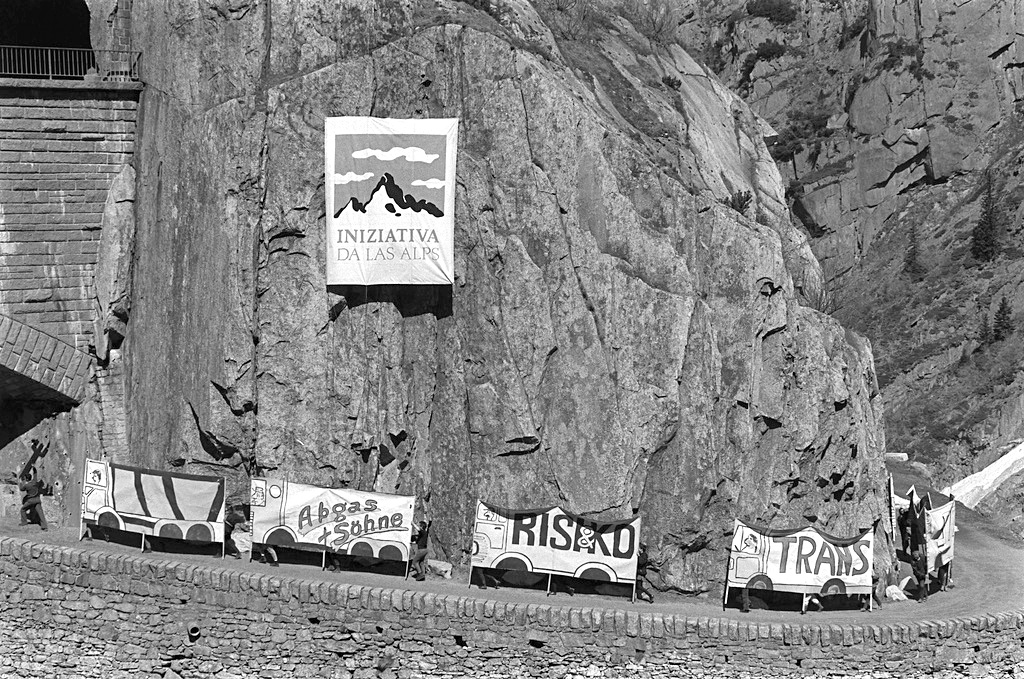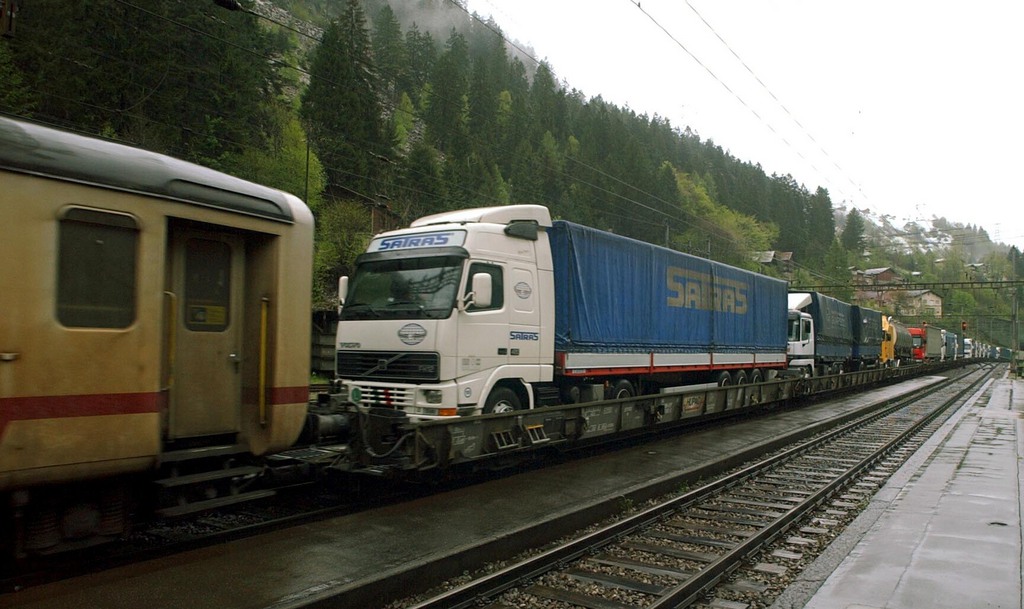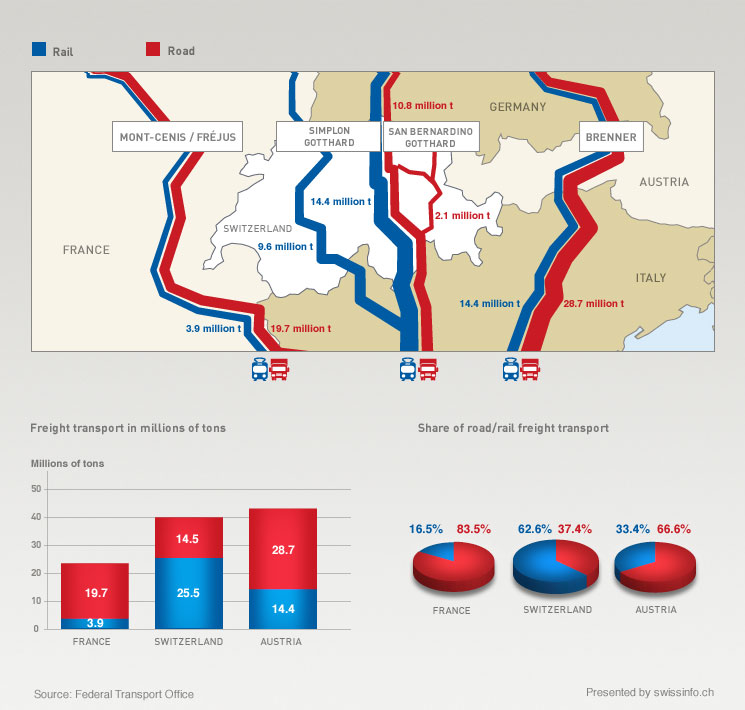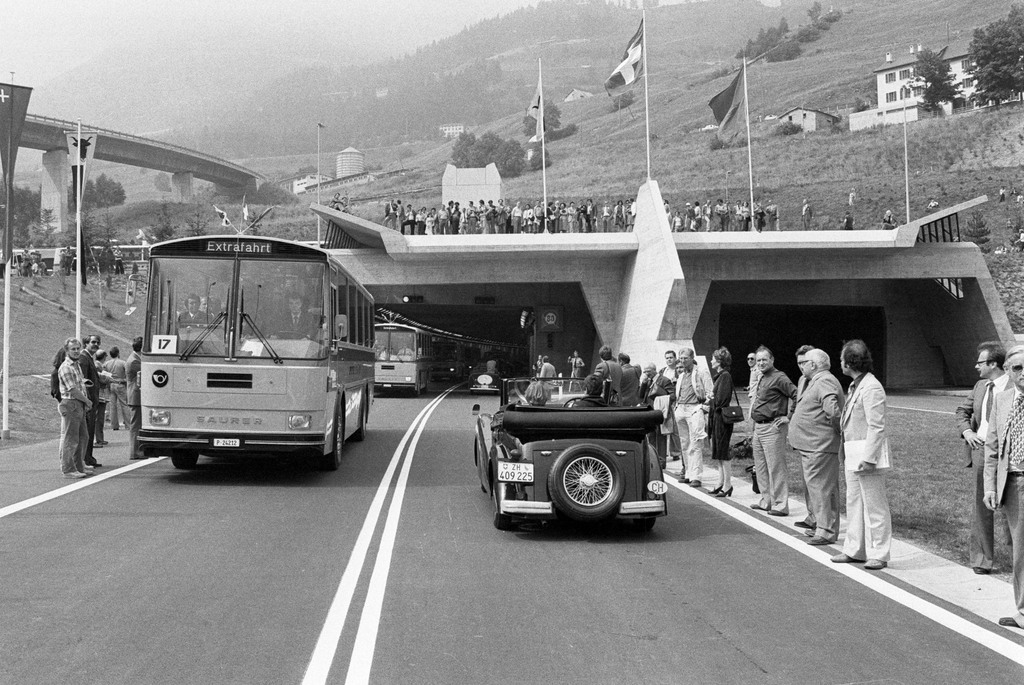After 20 years, Alpine truck traffic still not on track

Two decades ago, Swiss voters surprisingly accepted an initiative aimed at protecting the Alps from transit traffic. While the result led to a change in transportation policy, shifting freight from road to rail has been in the slow lane ever since.
On that night of February 20, 1994, then-transport minister Adolf Ogi must have had trouble getting to sleep.
The nation’s voters had just accepted the “Alpine Initiative”. The “yes” side had won with 51.9% of the votes and 19 cantons out of 26, and the popular Swiss People’s Party politician had just acquired the dubious distinction, held by few ministers at the time, of being disavowed at the ballot box after having conducted a campaign against a popular initiative.
“It was indeed a big shock. It was David winning against Goliath, represented by the government and all the institutions who were against the initiative,” recalls Fabio Pedrina, president of the Alpine Initiative association.
The result enshrined a new principle in the Swiss Constitution: the Alpine environment was to be protected from the negative impacts of transit traffic. This principle was to be implemented by shifting goods traffic from road to rail and scrapping proposed additions to the existing national roads’ network.
Paradigm shift
“It is true that this vote took place in a context where environmental sensitivities were becoming more widespread. The result was a paradigm shift, though. It was a turning point. From the 1960s to the early 1990s the road system took up most of public investment, but after the vote the railways received more funding, gradually closing the gap with the budgets for roads,” says Pedrina.
This shift in public opinion and policy was confirmed afterwards, first in 1998, when the voters ratified a new tax on heavy vehicles and a project for funding public transport; and then in 2004, when a parliamentary proposal aimed at doubling the capacity of the Gotthard road tunnel was defeated at the polls.
Economist Angelo Geninazzi, a specialist in transport policy and the Swiss Business Federation’s representative for Italian-speaking Switzerland, says the Alpine Initiative was a turning point in policy.
“It succeeded in converting a large part of the population to the idea – certainly praiseworthy – that moving traffic from road to rail is something to be aspired to and that everything possible should be done to make it happen,” he adds.
But in Geninazzi’s view, the initiative led to a policy that was to some extent counterproductive, since road and rail were seen as competing rather than complementing one another.
Subsidies given to rail have also delayed structural changes and deterred innovation by the railways themselves, he says. “Road transport, which is heavily taxed, has become much more competitive and innovative compared to 20 years ago. If we think in terms of emissions, for example, trucks have gotten much cleaner.”

More
How the Swiss opted to protect the Alps
EU follows Swiss lead
The position adopted by Switzerland “spurred Europe to take up so many proposals and so many ideas thrown up by the Alpine Initiative, at least at the level of declarations”, emphasises Pedrina, who is a former centre-left Social Democrat parliamentarian.
In its 2011 white paper “Roadmap to a Single European Transport Area”, for example, the European Commission proposed a 2030 deadline for transferring to the railways 30% of goods traffic currently carried by trucks for trips longer than 300 kilometres. And in the taxation system for Alpine transit, an additional levy is being considered for “sensitive regions”.
“In its paper, the European Commission also says that road traffic is the main means of transport,” counters Geninazzi.
“The problem is that the policy of protecting the Alpine environment remains something very Swiss. It’s no accident that we have to fund the upgrading of the Bellinzona-Luino-Gallarate railway line leading from Ticino into Italy on the Italian side,” he adds.
“This is the major criticism that can be made of the Alpine Initiative and the policy which derived from it. We needed a joint approach involving other countries, but it didn’t happen.”
For Pedrina, however, this criticism should be addressed to the federal government and industry, which even before the vote on the initiative chose to go it alone without outside involvement, notably regarding the funding of the new trans-Alpine rail connections.
Pedrina also points out that “thanks to the tax on heavy traffic, which was one of the most effective instruments created in the wake of the Alpine Initiative, foreign truckers now provide a significant financial contribution to Swiss transportation policy.”
Lack of political will?
However, a glance at the share of goods traffic actually transported by rail in the different Alpine countries dismisses any illusion that things are now on track (see infographic).

More
Road or rail?
Swiss legislation sets a ceiling of 650,000 annual transits by trucks, a limit to be achieved two years after the opening of the Gotthard base railway tunnel, which is expected in 2016. Currently there are about 1.2 million trucks crossing the Swiss Alps, and last November the government revealed that the target would not be reached in time.
Still, Pedrina sees the glass as half full. “Without the Alpine Initiative, today it would be more like two million trucks.”
But he does not spare the government. “If the target is not being reached, it is just because of lack of political will,” he adds. “The parliamentary majority is still stuck in the early 1990s. No-one dares contest the idea of road-to-rail transfer, but when it’s time to back up the talk…”
The Alpine Crossing Exchange is a proposed instrument based on market mechanisms, the purpose of which is to encourage the transfer of freight traffic from road to rail.
In practice this would mean that a maximum number of heavy vehicles in transit through the Alps is fixed annually, and these transit credits are sold to the highest bidder. The credits would apply to all the alpine passes in the country, while it would be left up to the transporters to choose their own route.
The president of the Alpine Initiative cites, as an example, the government’s decision to build a second Gotthard road tunnel so as to renovate the old one (which is to be closed for several months) as well as the choice not to introduce an Alpine Crossing Exchange (see infobox) that would allow transport companies to trade transit rights.
For Geninazzi, the reasons for not achieving the target needs to be sought elsewhere, as the slipping share of rail shipping – from 70% in 2000 to 63% in 2012 – shows.
“Today’s shipments are getting smaller and often they have to be shipped ‘just in time’, from one day to the next,” he points out.
“The railway does not allow this kind of flexibility. What’s more, for shipments shorter than 400-500 kilometres, rail is not an option. So you can tax as much as you like and give the railways massive subsidies, but in many cases companies just need to ship by road.”
(Translated from Italian by Terence MacNamee)

In compliance with the JTI standards
More: SWI swissinfo.ch certified by the Journalism Trust Initiative











You can find an overview of ongoing debates with our journalists here . Please join us!
If you want to start a conversation about a topic raised in this article or want to report factual errors, email us at english@swissinfo.ch.